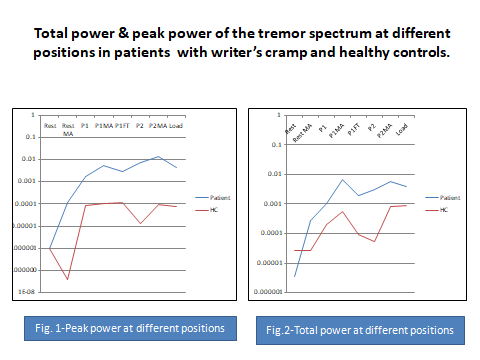Category: Tremor
Objective: To define the electrophysiological characteristics of tremor in patients with writer’s cramp.
Background: Writer’s cramp is a common form of focal, task-specific dystonia which involves the upper extremity during the act of writing. Combined tri-axial accelerometry-surface electromyography analysis is the gold standard electrophysiological technique to quantify tremor objectively. In this descriptive study, we analysed the data generated by tri-axial accelerometer measurementsin patients with writer’s cramp and tremor.
Method: We recruited 11 patients with writer’s cramp. Participants underwent standardized tremor analysis using combined tri-axial accelerometry-electromyography (EMG) analysis. Tremor was recorded with the accelerometer placed on the middle phalanx of the index finger in the following positions i.e., rest , rest with mental activation, arms outstretched and elbows extended (P1), P1 with mental activation, P1 with finger tapping, P1 with 500g load, arms outstretched and elbow flexed with fingers pointing toward each other (P2 ) and P2 with mental activation. After Power Spectral Density (PSD) transform, Peak frequency (PF), Peak Power (PP) and Total Power (TP) were derived for the frequency range 1-30Hz.
Results: Tremor peak frequency ranged between 3.39± 1.74Hz to 7.39 ± 2.88Hz in various positions with positions specific changes >1Hz. Peak power and total power were maximum in P2 with mental activation and P1 with mental activation respectively, 0.014±0.046 and 0.00685±0.018(g)2/Hz-Hz.
Conclusion: Posture with arms abducted at shoulder, elbows flexed and pronated with the fingertips pointing towards each other elicited highest amplitudes of tremor at peak frequency in writer’s cramp. This was followed by the standard position of arms abducted and outstretched. Mental activation increased tremor amplitude in both positions. The ‘wing beating’ position should be routinely assessed in the clinicwhile observing for tremor in task specific focal hand dystonia. Our results also indirectly support the hypothesis of a predilection of dystonic tremor to involve proximal muscles.
References: [1] Panyakaew P, Cho HJ, Lee SW, Wu T, Hallett M. The Pathophysiology of Dystonic Tremors and Comparison With Essential Tremor. J Neurosci. 2020 Nov 25;40(48):9317-9326. doi: 10.1523/JNEUROSCI.1181-20.2020. Epub 2020 Oct 23. PMID: 33097635; PMCID: PMC7687063.
[2] Bove F, Di Lazzaro G, Mulas D, Cocciolillo F, Di Giuda D, Bentivoglio AR. A role for accelerometry in the differential diagnosis of tremor syndromes.Funct Neurol. 2018 Jan/Mar;33(1):45-49. doi: 10.11138/fneur/2018.33.1.045. PMID: 29633696; PMCID: PMC5901940.
[3] Bain PG, Findley LJ, Britton TC, Rothwell JC, Gresty MA, Thompson PD, Marsden CD. Primary writing tremor.Brain. 1995 Dec;118 ( Pt 6):1461-72. doi: 10.1093/brain/118.6.1461. PMID: 8595477.
[4] Hallett M. Pathophysiology of writer’s cramp. Hum Mov Sci. 2006 Oct;25(4-5):454-63. doi: 10.1016/j.humov.2006.05.004. Epub 2006 Jul 21. PMID: 16859794.
[5] Zakin E, Simpson DM. Botulinum Toxin Therapy in Writer’s Cramp and Musician’s Dystonia. Toxins (Basel). 2021 Dec 14;13(12):899. doi: 10.3390/toxins13120899. PMID: 34941736; PMCID: PMC8708945.
To cite this abstract in AMA style:
D. Biswas, R. Anandapadmanabhan, A. Vishnoi, R. Rajan, A. Srivastava. Electrophysiological analysis of tremor in patients with writer’s cramp [abstract]. Mov Disord. 2022; 37 (suppl 2). https://www.mdsabstracts.org/abstract/electrophysiological-analysis-of-tremor-in-patients-with-writers-cramp/. Accessed December 31, 2025.« Back to 2022 International Congress
MDS Abstracts - https://www.mdsabstracts.org/abstract/electrophysiological-analysis-of-tremor-in-patients-with-writers-cramp/

